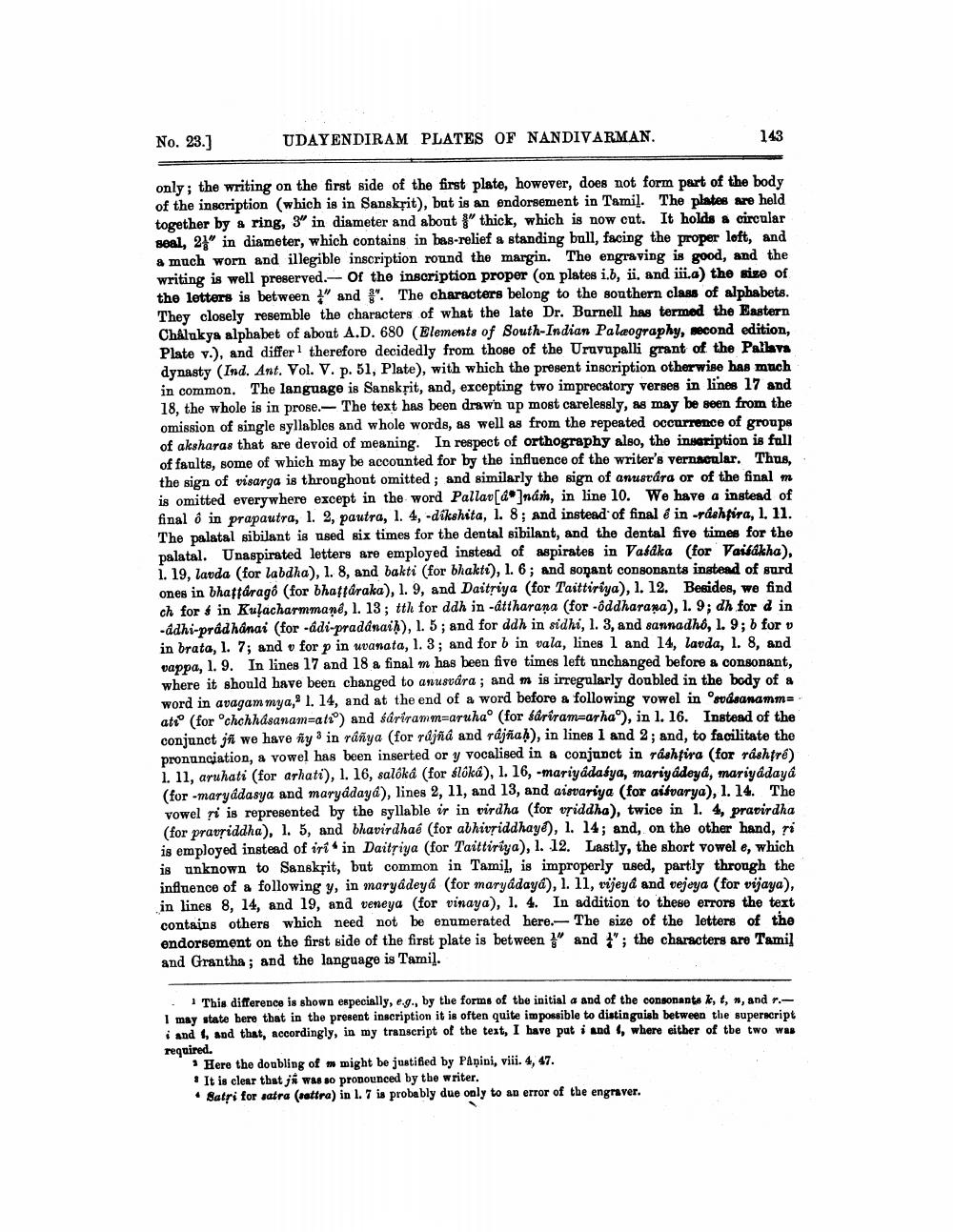________________
No. 23.]
UDAYENDIRAM PLATES OF NANDIVARMAN.
143
only; the writing on the first side of the first plate, however, does not form part of the body of the inscription (which is in Sanskrit), but is an endorsement in Tamil. The plates are held together by a ring, 3' in diameter and about !" thick, which is now cut. It holds a circular soal, 21" in diameter, which contains in bas-relief a standing bull, facing the proper loft, and a much worn and illegible inscription round the margin. The engraving is good, and the writing is well preserved. Or the inscription proper (on plates i.b, ii. and iii.a) the size of the letters is between " and " The characters belong to the southern class of alphabets. They closely resemble the characters of what the late Dr. Barnell has termod the Eastern Chalukya alphabet of about A.D. 680 (Elements of South Indian Palæography, second edition, Plate v.), and differ therefore decidedly from those of the Uravupalli grant of the Pallava dynasty (Ind. Ant. Vol. V. p. 51, Plate), with which the present inscription otherwise has much in common. The language is Sanskrit, and, excepting two imprecatory verses in lines 17 and 18, the whole is in prose. The text has been drawn up most carelessly, as may be seen from the omission of single syllables and whole words, as well as from the repeated occurrence of groups of aksharas that are devoid of meaning. In respect of orthography also, the inscription is full of faults, some of which may be accounted for by the influence of the writer's vernacular. Thus, the sign of visarga is throughout omitted ; and similarly the sign of anustára or of the final m is omitted everywhere except in the word Pallav[do]nán, in line 10. We have a instead of final ô in prapautra, 1. , pautra, 1. 4, -dikshita, 1. 8; and instead of final & in -rdshfira, 1. 11. The palatal sibilant is used six times for the dental sibilant, and the dental five times for the palatal. Unaspirated letters are employed instead of aspirates in Vafdka (for Paifakha), 1. 19, lavda (for labdha), 1. 8, and bakti (for bhakts), 1. 6; and sonant consonants instead of surd ones in bhaffäragð (for bhaffäraka), l. 9, and Daitriya (for Taittiriya), 1. 12. Besides, we find ch for $ in Kulacharmmand, 1. 13; tth for ddh in -attharana (for-oddharana), 1. 9; dh for d in -adhi-pradhanai (for-di-pradanaih), 1.5; and for ddh in sidhi, 1. 3, and sannadho, 1. 9; 6 for v in brata, 1. 7; and for p in wanata, 1. 3; and for b in vala, lines 1 and 14, lavda, 1. 8, and vappa, 1. 9. In lines 17 and 18 a final m has been five times left unchanged before & consonant, where it should have been changed to anusvára ; and m is irregularly doubled in the body of a word in avagam mya, I. 14, and at the end of a word before a following vowel in evdeanamma atro (for 'chchhasanam-ato) and sáriramm=aruhao (for fåriram=arhao), in l. 16. Instead of the conjunct jf we have ny in ránya (for rdjña and rajñaḥ), in lines 1 and 2; and, to facilitate the pronunciation, a vowel has been inserted or y vocalised in a conjunct in rashfira (for ráshtré) i. 11, aruhati (for arhati), 1. 16, salóká (for flóká), 1. 16, -mariyâdasya, mariyadoyd, mariyadaya (for-maryddasya and maryadaya), lines 2, 11, and 13, and aisvariya (for aitvarya), 1. 14. The vowel ri is represented by the syllable ir in virdha (for vriddha), twice in l. 4, pradirdha (for pravriddha), l. 5, and bhavirdhaé (for abhivriddhayê), . 14; and, on the other hand, ri is employed instead of iri' in Daitriya (for Taittiriya), 1. 12. Lastly, the short vowel e, which is unknown to Sanskrit, but common in Tamil, is improperly used, partly through the influence of a following y, in maryádeya (for maryadaya), 1. 11, vijeyd and vejeya (for vijaya), in lines 8, 14, and 19, and veneya (for vinaya), 1. 4. In addition to these errors the text contains others which need not be enumerated here. The size of the letters of the endorsement on the first side of the first plate is between " and "'; the characters are Tamil and Grantha; and the language is Tamil.
. This difference is shown especially, e.g., by the forms of the initial a and of the consonants k, l, m, and r. 1 may state bere that in the present inscription it is often quite impossible to distinguish between the superscript i and, and that, accordingly, in my transcript of the text, I have put i and, where either of tbe two was required.
* Here the doubling of m might be justified by PAņini, viii. 4, 47. : It is clear that j was so pronounced by the writer. • Batri for satra (rattra) in 1. 7 is probably due only to an error of the engraver.




